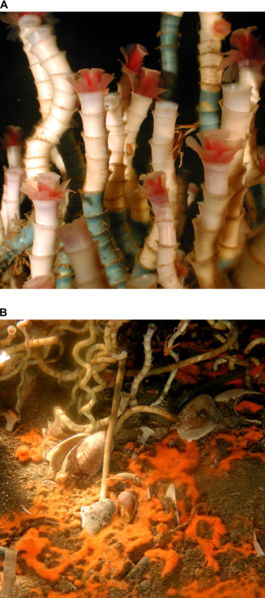File:Lamellibrachia luymesi.jpg

Original file (2,020 × 4,560 pixels, file size: 1.07 MB, MIME type: image/jpeg)
A) Close-up photograph of the symbiotic vestimentiferan tubeworm Lamellibrachia luymesi from a cold seep at 550 m depth in the Gulf of Mexico. The tubes of the worms are stained with a blue chitin stain to determine their growth rates. Approximately 14 mo of growth is shown by the staining here. (Photo: Charles Fisher) (B) Close-up photograph of the base of an aggregation of the symbiotic vestimentiferan tubeworm L. luymesi from a cold seep at 550 m depth in the Gulf of Mexico. Also shown in the sediments around the base are orange bacterial mats of the sulfide-oxidizing bacteria Beggiotoa spp. and empty shells of various clams and snails, which are also common inhabitants of the seeps. (Photo: Ian MacDonald)
From: Microfauna–Macrofauna Interaction in the Seafloor: Lessons from the Tubeworm Boetius A PLoS Biology Vol. 3, No. 3, e102 doi:10.1371/journal.pbio.0030102
The Public Library of Science (PLoS) has chosen to apply the Creative Commons Attribution License (CCAL) to all works we publish (read the human-readable summary or the full license legal code). Under the CCAL, authors retain ownership of the copyright for their article, but authors allow anyone to download, reuse, reprint, modify, distribute, and/or copy articles in PLoS journals, so long as the original authors and source are credited. This broad license was developed to facilitate open access to, and free use of, original works of all types. Applying this standard license to your work will ensure your right to make your work freely and openly available. Learn more about open access!
Please direct your questions and comments to license [at] plos.org.
(This license replaces the previously posted versions of the open-access license—Version 1.0b and Version 1.0—as of 22 April 2003.) Summary of the Creative Commons Attribution License
Anyone is free to do the following:
* to copy, distribute, display, and perform the work * to make derivative works * to make commercial use of the work
The following conditions apply:
Attribution. You must give the original author and source credit.
This means:
* for any reuse or distribution, you must make clear to others the license terms of this work * any of these conditions can be waived if you get permission from the author
Your fair use and other rights are in no way affected by the above.
File history
Click on a date/time to view the file as it appeared at that time.
| Date/Time | Thumbnail | Dimensions | User | Comment | |
|---|---|---|---|---|---|
| current | 19:53, 11 March 2022 |  | 2,020 × 4,560 (1.07 MB) | Maintenance script (talk | contribs) | == Summary == Importing file |
You cannot overwrite this file.
File usage
The following page uses this file: